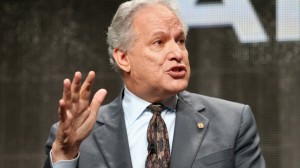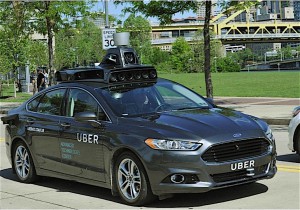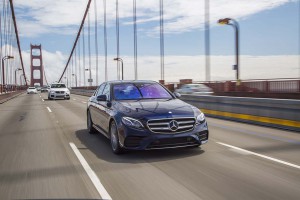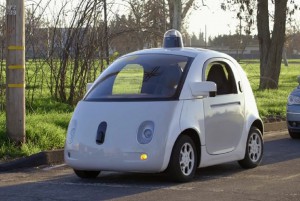As the big Mercedes-Benz sedan roars down U.S. 101 south of San Francisco, it closes on an old pickup truck cruising along in its lane. The driver flicks the turn signal for a pass, but then, unexpectedly, takes his hands off the wheel. The new sedan pauses for two seconds and then completes the maneuver on its own.
While it could be another five years or so until automakers roll out the first fully autonomous vehicles, they’re already beginning to introduce semi-autonomous features like the Auto Lane Change system on the new 2017 Mercedes-Benz E300, as well as Tesla’s new AutoPilot system. Traditionally, the industry has taken a go-slow approach to technology, typically waiting for new government rules and regulations. But in an unusual turnabout, federal regulators are letting the auto industry take the lead.
That’s pushing carmakers like Mercedes into something of a “gray zone,” said Bart Herring, the general manager of product management for Mercedes-Benz USA. Federal regulators “don’t want to stand in the way and that’s very progressive, something that we as a manufacturer really appreciate.”
At the same time, said Herring, following a media drive of the new Mercedes E300, it can create some serious uncertainty for a manufacturer trying to figure out where to draw the line. The new German sedan is loaded with features like Auto Lane Change Assist and can be driven hands-free for up to about 30 seconds at a time. But Mercedes has, for now, decided not to add another system that would let a driver summon the sedan from a parking spot remotely, with no one behind the wheel.
“In some cases, we feel we may be pushing (too far),” the executive said.
Traditionally, federal regulators run an extremely tight ship when it comes to authorizing the use of new technology. Even changing the color of a warning light has, at times, required a year or more of study and some intense rulemaking. But federal regulators have become convinced that approach could actually hinder, rather than advance, highway safety.

NHTSA chief Mark Rosekind continues to advocate for the increased acceptance and integration of autonomous vehicle technologies.
(Infiniti may add semi-autonomous technology to most new models. For more, Click Here.)
The National Highway Traffic Safety Administration “cannot move fast enough to regulate” all the new technologies that are being developed, “many of which aren’t necessarily breaking the rules simply because the regulations don’t exist,” said David Sullivan, a senior automotive analyst with consultancy AutoPacific, Inc.
Somewhat ironically, the shift in strategy is being led by Mark Rosekind, the NHTSA administrator who took over the agency in late 2014 amidst a series of major safety lapses by major manufacturers including General Motors, Toyota, Fiat Chrysler and Honda, as well as airbag supplier Takata.
The former head of the National Transportation Safety Board Rosekind decided to mimic the carrot-and-stick approach used in the aerospace world, cracking down on safety lapses while encouraging automakers to bring new technological breakthroughs to market if there was solid evidence they would work.
U.S. Transportation Secretary Anthony Foxx gave the agency its marching orders during an appearance at the Detroit Auto Show last January, declaring, “Automated vehicles open up possibilities for saving lives, saving time and saving fuel.”
NHTSA Administrator Rosekind took things a step further during an appearance at a connected car conference in the Motor City earlier this month, declaring, “Our goal is to hasten this revolution.” Rosekind made it clear that not only can’t NHTSA keep up with the revolution in onboard technology, but even when it does come up with rules, it will need to be flexible. “Today everybody expects a regulation comes out and that’s what it is forever. That will not work.”
Not everyone is pleased by this approach. NHTSA is in the midst of creating broad umbrella rules for autonomous vehicles, a process it hopes to complete this year. But some safety advocates have warned the agency it could be moving too fast – and giving the industry too free a hand. Some industry proposals are “not merely foolhardy (but) dangerous, Consumer Watchdog director John M. Simpson warned at one session.
(Click Here for details about Marchionne’s talks with Uber and Amazon.)
But going back to the old process would mean that many technical breakthroughs won’t reach market, or could take years to do so, and that approach “could cost lives,” said Mercedes’ Herring.
For his part, analyst Sullivan said he expects some technologies won’t work as well as expected as they migrate from lab to highway. Tesla, for example, had to update the initial version of the AutoPilot system because some owners were using it in ways the battery-carmaker hadn’t anticipated.

Uber has already started testing autonomous vehicles with an eye toward using them in their regular ride-sharing fleet someday.
The good news, according to Sullivan, was Tesla’s ability to update the underlying software through over-the-air updates, a process similar to the way smartphone makers routinely revise their operating systems. Industry analysts expect over-the-air, or OTA, updates to become widely used by the end of the decade, driven in large part by the need to manage all the technology going into today’s new cars.
Smart technologies are already showing real benefits. A report released early this year by the Insurance Institute for Highway Safety found that radar and laser-based forward collision warning systems reduced rear-end crashes by nearly 20%, and that figure nearly doubled when the system added the ability to automatically apply the vehicle’s brakes if a driver didn’t respond quickly enough.
Eventually, NHTSA Rosekind has said, he believes autonomous technologies could virtually eliminate U.S. highway crashes and fatalities, a figure that was expected to top 34,000 for 2015, once final data is tallied.
(New study sees 21 million autonomous vehicles on the road by 2035. Click Here for the latest.)
But regulators and automakers are together entering a gray zone in which the unexpected is possible, often with no clear rules to guide them. The next several years will reveal whether this approach can work to the benefit of those traveling the nation’s highways.
(This story first appeared on NBCNews.com.)


